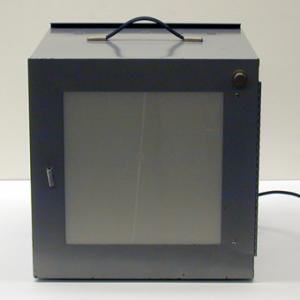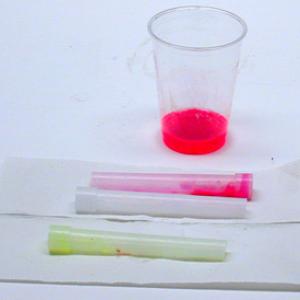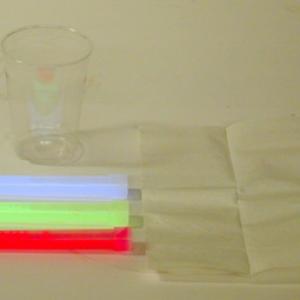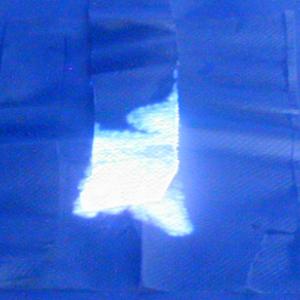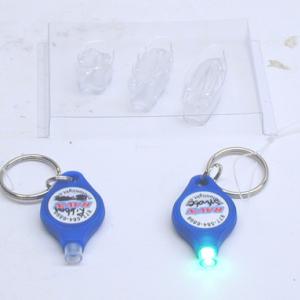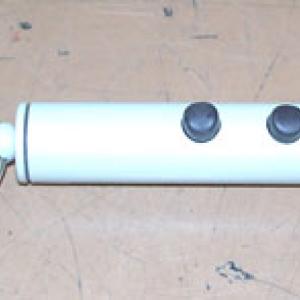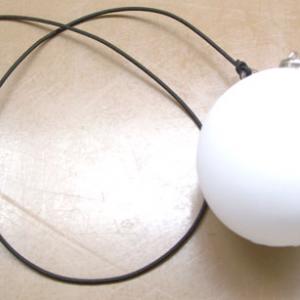College of Liberal Arts & Sciences
6F10.10 - Color Box and Color Mixing
Varying amounts of red, blue, and yellow light are mixed together to make different colors with the color box. Each color is on its own Variac so that the intensities and amount of colors added can be controlled.
Snap the light sticks to that they start to glow. Cut the end off of each light stick with the razor blade and pour into the plastic cup. Dip a paper towel into the cup and absorb some of the liquid. This liquid should give off a nice white glow.
NOTE: When the three liquids are poured into the cup the resulting mixture will have a red tint. This is due to the dye that is in the red light stick and the thickness of the dye that the light is moving through. The light moves through very little dye when the liquid is on the paper towel, thus giving a white color.
The large and small light bars all show the same phenomenon. The very large light bar has LED lights and is used for large classes or audiences. Look at the lights through a grating and observe that each individual color has a unique spectrum. This light bar also has switches on each individual bulb so you can look at only one color at a time if desired. The medium size light bar has LED's whose colors can be changed with the control panel to show the spectrum of the individual colors. The small light bar also has a switch so that you can have all the LED's on at the same time or turn them on one at a time if desired. This one is small enough so that it is most useful in a smaller classroom or with a small audience.
- Paul Hewitt, "Figuring Physics", TPT, Vol. 61, #6, Sept. 2023, p. 531.
- Hwa-Ming Nieh, Huai-Yi Chen, "An Arduino-Based Experimental Setup for Teaching Light Color Mixing, Light Intensity Detection, and Ambient Temperature Sensing", TPT, Vol. 61, #2, Feb. 2023, p. 133.
- Rucheng Dai, Zhongping Wang, Zengming Zhang, Lazhen Sun, "A Color-Mixing Setup for a Physics Teaching Laboratory", TPT, Vol. 60, #8, Nov. 2022, p. 677.
- C. Hanisch, M. Ziese, W. Oehme, "Newton's Green and Goethe's Purple - Color Experiments With LEDs", TPT, Vol. 59, #9, Dec. 2021, p. 712.
- Jennifer Birriel, "Glow Sticks: Spectra and Color Mixing Revisited", TPT, Vol. 59, #7, Oct. 2021, p. 586.
- Tina Schulze, Gunter Quast, Antje Bergmann, Roman Dengler, "An Approach to a Physical Understanding of Color Mixing", TPT, Vol. 58, #6, Sept. 2020, p. 388.
- Nada Razpet, Tomaz Kranjc, "Partially Covered Lenses and Additive Color Mixing", TPT, Vol. 55, #9, Dec. 2017, p. 537.
- Wenqing Sun and Jun Wang, "Demonstration for Additive Colors by Defocus Blur", TPT, Vol. 57, #7, Oct. 2019, p. 498.
- Jennifer Birriel, "RGB Screens: Some Fun Optics", TPT, Vol. 56, #7, Oct. 2018, p. 488.
- Paulo Simeão Carvalho and Marcelo Hahn, "A Single Experimental Setup for Teaching Additive Colors with Arduino", TPT, Vol. 54, #4, Apr. 2016, p. 244.
- Jennifer Birriel and Ignacio Birriel, "Glow Sticks: Spectra and Color Mixing", TPT, Vol. 52, #7, Oct. 2014, p. 400.
- Lars-Jochen Thoms, Giuseppe Colicchia, and Raimund Girwidz, "Color Reproduction With a Smart-Phone", TPT, Vol. 51, #7, Oct. 2013, p. 440.
- Andrew Morrison, "Many Uses For the 'Mysterious Glowing Ball'", TPT, Vol. 48, #8, Nov. 2010, p. 557.
- Chris Chiaverina, "The Ping-Pong Ball Color Mixer Revisited", TPT, Vol. 45, #2, Feb. 2007, p. 120.
- Adolf Cartel, "Simple Experiments on Perception of Color Using Cardboard Turbines", TPT, Vol. 42, #6, Sept. 2004, p. 377.
- L. M. Gratton, M. Perini, and V. Zanetti, "Compact Fluorescent Lamp Observed Through a Diffraction Grating", TPT, Vol. 42, #5, May 2004, p. 270.
- Gorazd Planinšič, "Color Mixer for Every Student", TPT, Vol. 42, #3, Mar. 2004, p. 138.
- John Cockman, "A Bright Color Mixer", TPT, Vol. 40, #9, Dec. 2002, p. 553.
- Larry Russell, "Color Mixing with Lasers", TPT, Vol. 39, #8, Nov. 2001, p. 475.
- A. Alan Middleton and Samuel Sampere, "Color Mixing via Polarization", TPT, Vol. 39, #2, Feb. 2001, p. 123.
- Lawrence D. Woolf, "Comments from Woolf", TPT, Vol. 37, #6, Sept. 1999, p. 326.
- John Clement, "Clarifying Confusion", TPT, Vol. 37, #6, Sept. 1999, p. 326.
- Lawrence D. Woolf, "Confusing Color Concepts Clarified", TPT, Vol. 37, #4, Apr. 1999, p. 204.
- Leonard Parsons, "As Easy as R, G, B", TPT, Vol. 36, #6, Sept. 1998, p. 347.
- Robert M. Williamson, "Filters for Color Mixing", TPT, Vol. 36, #1, Jan. 1998, p. 22.
- J. C. Martínez‐Antón, M. Antón, and A. González‐Cano, "A Simple Colorimeter", TPT, Vol. 33, #6, Sept. 1995, p. 372.
- Cruse Melvin and Timothy Melvin, "Mixing Colors in the Hall", TPT, Vol. 33, #5, May 1995, p. 292.
- Joe L. Ferguson, "Tinkertoy(R) Color‐Addition Device", TPT, Vol. 33, #4, Apr. 1995, p. 242.
- Marinus G. Luttikhuizen, "Color Mixing Using a Single Projector", TPT, Vol. 26, #5, May 1988, p. 296.
- Walter Connolly and Ray Watterson, "Tri-Color LED Demonstrator", TPT, Vol. 25, #4, Apr. 1987, p. 234.
- Ronald Bergsten, "When Is Yellow Yellow?", TPT, Vol. 24, #7, Oct. 1986, p. 419.
- Haym Kruglak and Don Campbell, "Color Perception with Diffraction Gratings", TPT, Vol. 21, #5, May 1983, p. 312.
- Richard A. Bartels, "Using a Video Projector for Color-Mixing Demonstations", TPT, Vol. 20, #4, Apr. 1982, p. 247, also A Potpourri of Physics Teaching Ideas - Optics and Waves, p. 178.
- William A. Butler, A. Douglas Davis, and Charles E. Miller Jr., "Color Mixing for a Large Audience", TPT, Vol. 17, #1, Jan. 1979, p. 43.
- Valentina Roberti, Boris Kalinic, Tiziana Cesca, Luca Bacci, Giulio Peruzzi, "Maxwell's Color Box: Retracing the Path of Color Matching Experiments", AJP, Vol 90, #10, Oct. 2022, p. 787.
- Dudley H. Towne, "Teaching Newton's Color Theory Firsthand", AJP, Vol. 61, #2, Feb. 1993, p. 113.
- Sidney B. Lang, "Pyroelectricity: From Ancient Curiosity to Modern Imaging Tool", Physics Today, Vol. 58, #8, Aug. 2005, p. 31.
- Neil Ribe and Friedrich Steinle, "Exploratory Experimentation: Goethe, Land, and Color Theory", Physics Today, Vol. 55, #7, July 2002, p. 43.
- G. D. Freier and F. J. Anderson, "Oj-3", A Demo Handbook for Physics.
- "O-720: 3 Mirrors on Blocks", DICK and RAE Physics Demo Notebook.
- Martin C. Sagendorf, "Light Colors are Different than Pigment Colors", Physics Demonstration Apparatus, 2009, p. 15.
- A. D. Bulman, "Color-Mixing Apparatus", Model-Making for Physics, p. 38.
- Jearl Walker, "5.128: Seeing the Color of Your Mind", The Flying Circus of Physics with Answers.
- "Colored Shadows", Exploratorium Snackbook, p. 27.1 - 27.2.
- Kelvin Trefz, "Color Mixing", PIRA News, Vol. 3, #17, Jan. 1990, p. 3.
- Marsha M. Hobbs, "Using Holographic Diffraction Gratings for Lecture Demonstrations", PIRA News, Vol. 6, #5, Apr. 1992, p. 3.
- Readers Digest, "The Trick of Light that Gives a Colour Print", How in the World, p. 235.
- Ron Hipschman, "Distilled Light", Exploratorium Cookbook II, p. 105.1 - 105.4.
- The Magic Wand & Other Experiments in Light, p. 15.
- T. D. Rossing and C. J. Chiaverina, "Activity 2, Mixing Colors By Addition", Light Science, Physics and Visual Arts, p. 366.
- T. D. Rossing and C. J. Chiaverina, " 8.3, Additive Color Mixing (Revisited)", Light Science, Physics and Visual Arts, p. 178.
- Bernand Taylor, "The Proof of The Colour is in the Projection", Physics Education, Vol. 39, #4, July 2004, p. 324.
- Curt Suplee, "Light of Many Colors", Everyday Science Explained, National Geographic, p. 102 - 103.
- Borislaw Bilash II, “Colorful Mixtures“, A Demo A Day – A Year of Physical Science Demonstrations, p. 311.
Disclaimer: These demonstrations are provided only for illustrative use by persons affiliated with The University of Iowa and only under the direction of a trained instructor or physicist. The University of Iowa is not responsible for demonstrations performed by those using their own equipment or who choose to use this reference material for their own purpose. The demonstrations included here are within the public domain and can be found in materials contained in libraries, bookstores, and through electronic sources. Performing all or any portion of any of these demonstrations, with or without revisions not depicted here entails inherent risks. These risks include, without limitation, bodily injury (and possibly death), including risks to health that may be temporary or permanent and that may exacerbate a pre-existing medical condition; and property loss or damage. Anyone performing any part of these demonstrations, even with revisions, knowingly and voluntarily assumes all risks associated with them.
